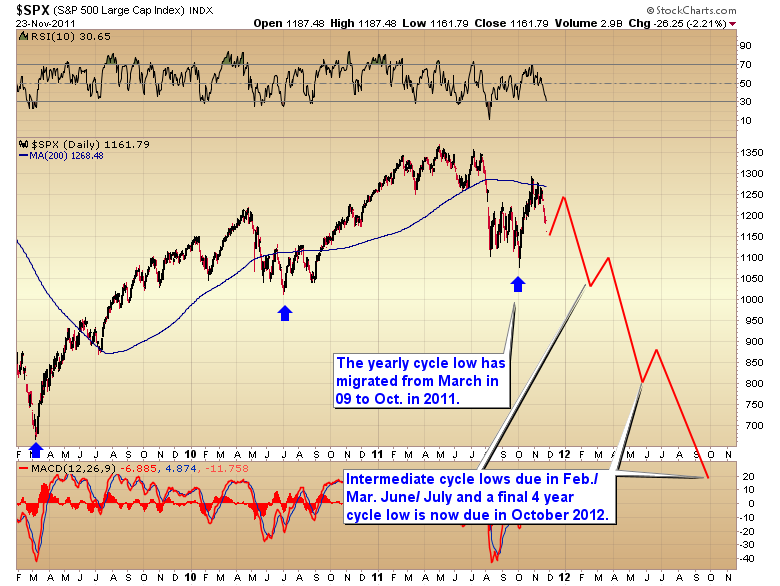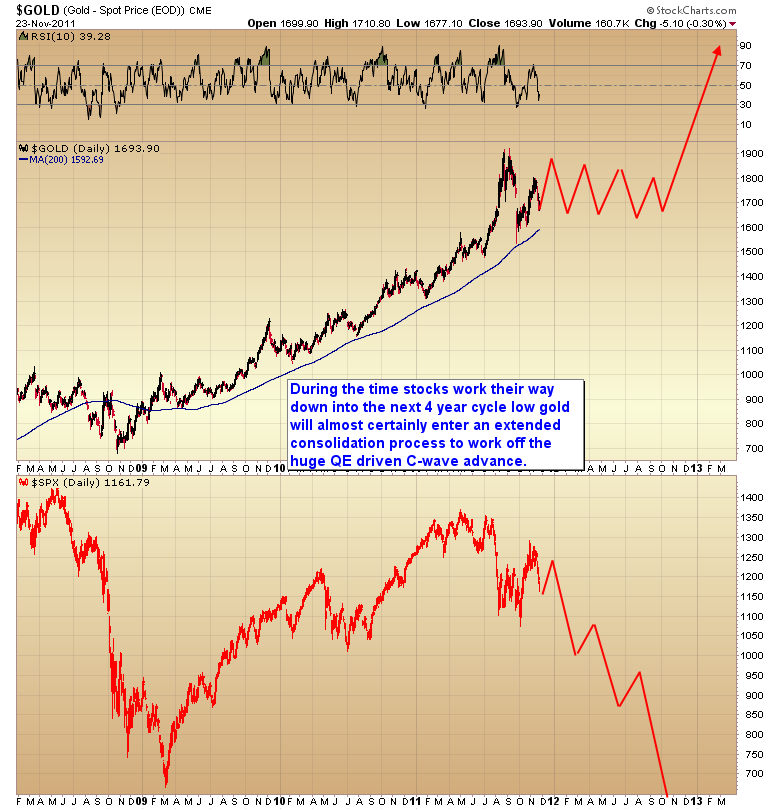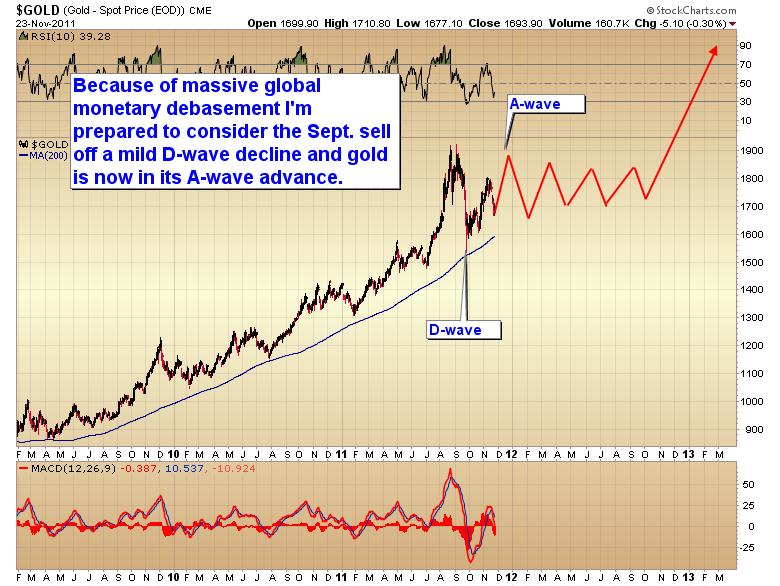The Secular Stocks Bear Market and Gold's A-Wave Trend Forecast
Stock-Markets / Financial Markets 2011 Nov 25, 2011 - 02:37 PM GMTBy: Toby_Connor
 I have decided to post the weekend premium report to the blog this week. In this report I'm going to take a look at what has transpired and what is likely to come, as the third leg down in the secular bear market begins to intensify.
I have decided to post the weekend premium report to the blog this week. In this report I'm going to take a look at what has transpired and what is likely to come, as the third leg down in the secular bear market begins to intensify.
Back in April of this year I warned investors to get out of stocks in their 401(k) accounts. At the time the dollar was moving into the timing band for a major three year cycle low. It has always been my expectation that the rally out of that major bottom would correspond with the stock market moving down into the third bear market leg of the secular trend that has been in place since 2000. As we now know the dollar did bottom in May of this year and that did correspond with the top of the cyclical bull market that began in March of 2009. It has also been my expectation that the next four year cycle low would occur in the fall of 2012, and that 2012 would be one of the worst economic years in human history.
This is already starting to unfold across the globe as social unrest that began in the Middle East has spread to Europe and now the United States. Economic data has been steadily eroding for months now. We should expect this trend to continue and intensify as we get into 2012.
As most of you know I use cycles and sentiment analysis to determine likely timing bands for major turns in the stock market, gold and the dollar. This is what allowed me to anticipate a bottom in the dollar cycle at a time when everyone was expecting the dollar to collapse, and a top in the stock market when everyone was bullish and expecting a move back to new highs.
An interesting development in the yearly cycle for the stock market has now emerged. Generally speaking most yearly cycles run about 12 months, trough to trough. However, the Fed's quantitative easing programs have stretched the yearly cycles from March 2009 into June of 2010, and this year the yearly cycle has stretched again to arrive in October. The market is now set up for the next yearly cycle low to occur in the fall of 2012 which, not surprisingly, is exactly when I have been expecting the next four year cycle low in stocks to bottom.

I have also indicated the expected timing bands for the next three intermediate degree cycle lows. For reasons explained in the nightly reports I don't think the current decline is going to move below the October low. I expect we will find a bottom sometime in the next 1-4 days followed by a Santa Claus rally into the middle of December.
If the market avoids making a lower low it will embolden the Bulls to continue holding long positions. Their hope for a miracle will be misplaced though as the market will almost certainly begin to roll over before making higher highs and by the next intermediate degree bottom in February/March we will see the October lows broken, and the summer 2010 lows tested.
The recent rally out of the October low will undoubtedly prove to have been the most powerful countertrend rally of this bear market. Any further countertrend rallies (and there will be several) are likely to be short-lived and weak. The window of opportunity for these long side trades is probably going to be too brief for the average investor/trader to successfully trade. From this point on investors should keep 401(k) accounts solely in money market funds until we reach the bottom sometime in the fall of 2012.
This brings us to the topic of gold. Despite what is happening in the stock market gold is clearly still in a secular bull market. That being said the days of easy money from the gold bull are probably over for the next year as stocks move down into their four year cycle low. In the chart below you can clearly see the affects QE1 & 2 had on the gold bull.

The QE programs drove the largest C-wave advance of gold's entire secular bull market. However, and for reasons I will explain below, I think the C-wave topped in September and gold is now going to enter an extended consolidation phase for the next year.
That begs the question if the C-wave has topped then where was the D-wave? Well, I think we just saw it in September. Let me explain.
Because of the massive liquidity floating around the world I now think the D-wave terminated with the overnight spike down to $1535 on September 26. I'm now seriously considering that the last D-wave was exceptionally mild because of the extreme global liquidity. If that is the case then gold has now entered an A-wave advance. As most of you know A-waves don't tend to make new highs. So my best guess is that gold will test the $1900 level sometime in the next three weeks followed by an extended corrective move down into an intermediate degree bottom in February (B-wave). That bottom should hold above the $1535 level. What should then follow will be a year-long frustrating and whipsawing consolidation that should terminate slightly before the stock market bottoms in the fall of 2012.

At that point gold will start to sniff out the next round of massive quantitative easing as the Fed and central banks around the world go into full panic mode and begin printing unimaginable amounts of money in the attempt to halt the global sovereign debt implosions and economic depression that will have developed.
As usual central planners will not account for the unintended consequences of their actions. This time quantitative easing is going to have the opposite affect that it did in 2009. Yes, it will put a bottom in stocks, at least temporarily, but it is also going accelerate the cancer that has now infected currency markets. And as currencies start to collapse so will global bond markets. This is the recipe for the final bubble phase in the gold bull market.
While gold is in this long consolidation phase/bear market phase for stocks, trading strategies will be vastly different than they were during QE1 and QE2. Trades are going to be shorter and there will be long periods of time where the correct strategy is to just sit in cash. I started to make the transition to this new trading strategy back in July. The recent breakdown in stocks has now eliminated any reservations I had about the bear market. With that confirmed, there is little doubt that gold has now entered an extended consolidation and that new trading strategies are called for.
Make no mistake; we are now entering what will be one of the toughest markets ever to make money in. So far the model portfolio is performing admirably even in these tough conditions.
For anyone who would like to sample the nightly premium newsletter, I have opened a $10 one week trial subscription. You will have full access to the SMT premium website including all historical archives, model portfolio, and terminology documentation for a full week. If during the week you decide the subscription is not for you, or the shorter term trading strategies don't suit you emotionally, then simply cancel your subscription by following the directions on the homepage prior to your week expiring.
Click here to go to the premium website then click on the subscribe link on the right-hand side of the page. You will see the special offer at the bottom of the subscription page.
Toby Connor
Gold Scents
GoldScents is a financial blog focused on the analysis of the stock market and the secular gold bull market. Subscriptions to the premium service includes a daily and weekend market update emailed to subscribers. If you would like to be added to the email list that receives notice of new posts to GoldScents, or have questions,email Toby.
© 2011 Copyright Toby Connor - All Rights Reserved
Disclaimer: The above is a matter of opinion provided for general information purposes only and is not intended as investment advice. Information and analysis above are derived from sources and utilising methods believed to be reliable, but we cannot accept responsibility for any losses you may incur as a result of this analysis. Individuals should consult with their personal financial advisors.
© 2005-2022 http://www.MarketOracle.co.uk - The Market Oracle is a FREE Daily Financial Markets Analysis & Forecasting online publication.



